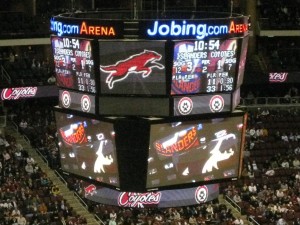
[This is the first part in a three-part series focusing of the long-running problems surrounding the Arizona Coyotes entitled “The Coyotes Saga”]
Back in the early to mid-1990s, the NHL was really going through the Gary Bettman expansion era with teams being added to non-traditional hockey markets like Tampa Bay, San Jose, Anaheim and the Greater Miami Area.
In addition to new expansion teams, the league saw teams move from northern markets like Quebec and Minnesota to the Midwest and South in Colorado and Dallas, respectively. Another one of those relocations involved the Winnipeg Jets moving to Phoenix, Arizona where they would be known as the Phoenix Coyotes.
For the first six years in the desert, the team saw success both on and off the ice. Led by Hall of Fame forward Jeremy Roenick, Keith Tkachuck and Rick Tocchet, the Coyotes made the playoffs in five of their first six seasons. The team saw over 96% of its arena capacity filled for the first three years, a statistic that can only be viewed as a success in any new market, let alone one in the Pacific Southwest.

With the aforementioned players as well as a young Shane Down on the wing, Teppo Numminen on defense and Nikolai Khabibulin in goal, the Coyotes appeared to be a young team ready to make the jump into the upper-echelon of NHL teams. Unfortunately, the perception of a great team on the rise just never became a reality.
Though the team made it to the playoffs plenty during their early years, the success in the postseason just wasn’t there. The Coyotes would fail to win a playoff series in each of those first five attempts. In fact, the organization wouldn’t win a series until their most recent trip to the playoffs in 2012, when they made it all the way to the conference finals before falling to the eventual Stanley Cup Champions, the Los Angeles Kings.
This lack of success in the postseason resulted in a decline that saw attendance drop in three straight years before a slight jump during the 2002-03 season. In addition to the on-ice shortcomings, it was clear that the place they called home, America West Arena, just wasn’t suitable enough for hockey.
Recent Coyotes Posts:
[catlist categorypage=yes numberposts=3 excludeposts=this]
At one end of the ice, a few sections of the lower level actually hung over the ice. This obstruction led to a quarter of the ice not being visible to those in the affected seats. This resulted in seats being covered as well as a second video board being installed in order to give fans in poor-sightline seats a way to watch the action. Tickets for these seats also had to be sold, as expected, at a reduced price.
The issues inside the arena with fans wasn’t the only major problem the Coyotes had to deal with, either. The organization was also locked into a terrible lease with the city-owned arena.
This lease in Phoenix saw the team lose $10-million or more every year the team was in the arena. At one point, the team had lost $40-million during a single season, nowhere near an amount that anyone would consider a “sustainable loss”.
The massive financial woes ultimately forced owner Richard Burke to sell the team after not being able to garner more investments into the franchise. In 2001, Burke sold the team to Steve Ellman, a developer from the Phoenix area; NHL Legend Wayne Gretzky would also come aboard as part owner.
With the ownership situation seemingly squared away, it was time to focus on the arena that the Coyotes called home. Because America West was so inadequate for hockey, a new building was built in suburban Glendale, Arizona. This new facility would open in 2003, and the Coyotes would move into the new facility shortly after the start of the 2003-04 NHL season. To coincide with the change in venue, Ellman completely rebranded the team with new colors, a new logo and new uniforms. It was a new era for the Coyotes.
And just when it would seem that things would get better for the franchise, time proved that that just wasn’t going to be the case.